van Bean — February 1, 2014
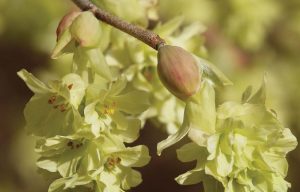
Winter-hazels comprise a group of underappreciated but versatile blooming shrubs. Trials at Longwood Gardens highlight selections worthy of receiving more attention from growers and landscape professionals alike.
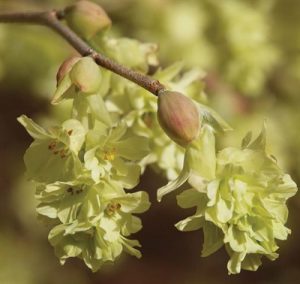
Click image to enlarge.
Corylopsis glabrescens ‘Longwood Chimes’ was selected for its longer than typical forms inflorescence, which retains the exceptional fragrance for which the species is known.
Photo courtesy of Sara Helm
A truly beautiful garden varies with the seasons, as dynamic as the plants that are its constituents. While most plants are admired at their peak, some have admittedly unfortunate appearances during their “off” season. Gardeners are thus challenged to choose plants that take the spotlight, then return to a sedate beauty that supports the acts to follow rather than sabotaging them.
Winter-hazels, or Corylopsis, are such plants. These elegant yet underappreciated shrubs bear glowing, pale yellow flowers in early spring, dangling like pendant earrings from graceful branches. After flowering they return to a quietly attractive state, silently gracing the garden until the spotlight returns to them next spring.
Click image to enlarge.
All Corylopsis look at home in a relaxed setting of the informal Conifer Knoll at Longwood Gardens.
Photo courtesy of Dr. Tomasz Anis_ko.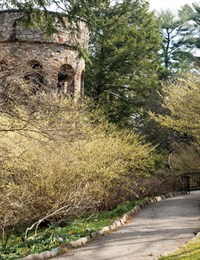
Possibly confusing but positively charismatic
Corylopsis is a small genus related to the more commonly grown Hamamelis, or witch-hazel. Winter-hazels bloom in the early spring, after Hamamelis, and have a more rounded growth habit. The name Corylopsis comes from corylus or “hazel” and the Latin suffix –opsis, meaning “resembling,” and refers to the strong resemblance of the plant, especially the leaves, to the genus Corylus. Unfortunately for gardeners and growers alike, the taxonomy of Corylopsis seems to be in perpetual review, and the exact number of species has varied from seven to more than 30. Most of the literature favors fewer species, though in some cases this creates wide variability within each taxon and makes it difficult for nurseries and gardeners to know what they are growing.
The genus ranges from the eastern Himalayas to Japan. The three or four species native to Japan, Corylopsis glabrescens, C. gotoana (sometimes treated as a variant of C. glabrescens), C. pauciflora and C. spicata, are the most distinctive; thus their names and descriptions have remained more stable than the species found in mainland Asia. The Japanese species also have very restricted natural distributions, growing only in isolated areas associated with serpentine rock outcroppings with ample moisture and sun.
The Chinese and Himalayan species are found in montane forests. The most widely recognized species from China, Corylopsis sinensis, represents a group of taxa that have been split and reunited numerous times, though all share certain traits, including large size. Of the members of the genus Corylopsis, the species C. sinensis, C. glabrescens, C. spicata and C. pauciflora and their cultivars are the most commonly available and the best suited to southeast Pennsylvania and most of the United States, though gardeners in the Pacific Northwest and cooler areas of the Southeast have a wider selection. One of the graceful yet underused shrubs described in this article is sure to fit a client’s garden—or your inventory.
Winter-hazels sold in nurseries, unless they are named, vegetatively propagated cultivars, may be highly variable. This means that size, growth habit and scent can all be quite different, making selection of material for propagation and sale very important. Size is mostly dependent on the species selected. Corylopsis sinensis and its various forms are the largest, followed by C. glabrescens, C. spicata and C. pauciflora, the lowest-growing species in the genus.
Growth habit can vary from broad and spreading to vase-shaped to more upright. The flowers, a glowing shade of soft yellow that varies only minutely across the genus, can carry an intoxicating scent like sweet primroses, and the first time one encounters a winter-hazel the plant may be smelled before it is seen. Unfortunately, this scent is also highly unpredictable and may represent a key factor in selecting forms for propagation and sale. The cultivars will, of course, be more uniform, though Corylopsis remains a genus from which much selection can be done to add to the short list of existing cultivars and improve uniformity in the market.
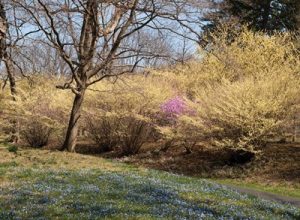
Click image to enlarge.
Winter-hazels typically benefit from some afternoon shade when grown in areas with hot summers, as shown here at Winterthur Gardens in Delaware.
Photo courtesy of Evan Bean.
Given the taxonomic jumble of species like Corylopsis sinensis, cultivars would be useful in horticulture for distinguishing various forms within the species. Propagation of such selections is simple, as softwood cuttings root readily. Some sources recommend that, like other members of the witch-hazel family, Corylopsis cuttings are best left in their propagation beds for one winter to harden off before potting them up. Others claim that Corylopsis cuttings are more resilient and do not need this overwintering.
The cultivation of Corylopsis
Winter-hazels prefer much the same conditions as Hamamelis, flowering best in full sun to light shade. Despite their natural occurrence in exposed sites in Japan, these shrubs typically benefit from some afternoon shade during the summer in southeast Pennsylvania.
Like other members of the witch-hazel family, Corylopsis has few problems with pests or diseases. Soil should be well-drained, acidic and high in organic matter. Amending the soil with peat moss or leaf mold is recommended to achieve these conditions. Keep winter-hazels evenly moist, as they will not tolerate prolonged drought. While full sun will encourage the most bloom, the plants will require more water and may still develop leaf spots or burnt edges from exposure to drying winds or hot sun.
Winter-hazels look their absolute best when grown in a woodland setting, either under a high canopy that provides dappled shade, or on the edge of the trees where they can receive morning sun with protection from hot afternoon rays. The bright shade just under the bows of more open trees seems to give the perfect amount of light for winter-hazels to produce ample flower buds and promote a graceful habit while protecting them from wind and late frosts.
Unfortunately, as with many shrubs that bloom in early spring, such frosts can damage the blooms. The flower buds and even partially open flowers are quite hardy, but fully open blooms will be damaged by temperatures much below freezing. Some reports claim that open flowers of winter-hazel are undamaged down to 10°F, while others are more conservative at 20°F. Whether either of these estimates is accurate is up for debate. Corylopsis buds expand quickly in response to warm temperatures in early spring. However, the flowers themselves open relatively slowly, and not all buds will open simultaneously, so that even if the first few flowers are killed by a random frost there are more blooms waiting to unfold.
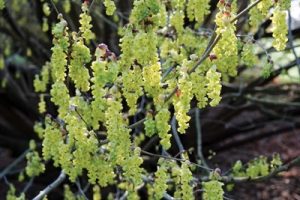
Click image to enlarge.
Corylopsis platypetala opens its long racemes a few days after Corylopsis sinensis.
Photo courtesy of Dr. Tomasz Anis_ko.
Pruning is best kept to a minimum, limited to accentuating or revealing the natural grace of these beautiful shrubs. Some species, especially Corylopsis pauciflora, can become quite dense naturally, particularly when grown in full sun. While many gardeners will find this pleasingly full, others may find the numerous stems too busy. For gardeners of the former opinion, winter-hazels are very low-maintenance shrubs that can be allowed to grow with only occasional removal of deadwood or rubbing branches. Gardeners who prefer a more open, architectural plant can train young winter-hazels to a few main stems and prune subsequent basal growth. As the plant matures and the selected stems become more dominant, they may also suppress basal growth to some extent, reducing maintenance over time.
Pruning should be done after flowers fade in spring. Pruning from midsummer to winter will remove the flower buds that have formed for the following spring. Locating winter-hazels in more shade will likewise make for a more open branch structure rather than the dense shape acquired with full sun.
An obliging color and form in the landscape
The main ornamental feature of winter-hazels is the primrose-yellow flowers, which are fairly uniform throughout the genus. The soft yellow beautifully complements other spring-blooming flowers, certainly easier on the eye and more pleasing in combinations than the harsh yellow of forsythia. However, none of the species in the genus Corylopsis is particularly suited for formal or highly manicured gardens, with the possible exception of C. pauciflora. These graceful shrubs generally look much more at home in an informal or woodland setting, ideally planted against a dark evergreen backdrop. That said, winter-hazels make a surprisingly enchanting espalier when skillfully trained on a wall or fence.
Corylopsis spicata and C. pauciflora, as the smallest members of the genus, are generally more suited to today’s gardens. Corylopsis pauciflora has a pleasingly rounded, dense habit suitable for smaller borders as well as woodland gardens. Corylopsis spicata is coarser and wilder in appearance. The form is unusual enough to provide winter interest, but not so strange as to defy attempts to mesh with the rest of the garden.
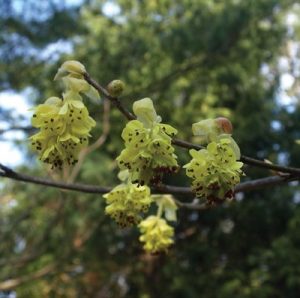
Click image to enlarge.
Dark purple to red anthers of Corylopsis spicata contrast with yellow petals.
Photo courtesy of Evan Bean
The larger species, Corylopsis glabrescens and C. sinensis, are better left to larger gardens, though they could also be used as small trees themselves if trained to a few upright stems and pruned high.
Winter-hazel branches can be brought inside for a good blooming display up to two months before the normal bloom season in mid-March. A research project on forcing branches of spring-blooming woody shrubs at Longwood Gardens found that Corylopsis can be forced with some success. Corylopsis pauciflora and C. glabrescens were rated in the top 10 out of 32 shrubs tested. Branches of Corylopsis pauciflora are best collected in February for flowers in early March, up to two weeks before their normal bloom season. Branches collected in January for a February display had about half as many flowers but were still showy enough for use.
Branches of Corylopsis glabrescens are best collected in January or early February for a February display. Corylopsis ‘Winterthur’ forces best when collected at the beginning of February for displaying that month. C. spicata produced few flowers under forced conditions, but if one is truly desperate for winter-hazel blooms, this species can be collected and forced at the beginning of December, and the branches will flower just in time for Christmas or New Year’s Day.
Variations on a theme
Young winter-hazels all look rather similar at first glance, yet the different species and cultivars mature into plants varied enough that there is a Corylopsis fit for most every garden if the right species or cultivar is selected. Subtle traits like the curve of branch tips or the size and color of flower buds may seem trivial, but can create surprisingly different effects when the plants are viewed as a whole. Though the flower color is practically the same throughout the genus, individual flowers vary in size and the length of the dangling inflorescences, ranging from less than 1 inch to over 3 inches long.
Other traits to consider when selecting the right winter-hazel for a garden are the color, size and texture of the leaves, the diameter and density of the branches and twigs, retention of old fruit and fall foliage color.
To gain better understanding of the choices offered by various species and varieties currently in cultivation, Longwood Gardens in Kennett Square, Penn. (USDA hardiness zone 7a), trialed 13 different Corylopsis for seven years. They were planted in full sun in mulched nursery beds. The data collected in the field trials were then compared with observations of fully established plants growing under varied conditions in the public areas of the gardens, in some cases for more than 50 years.
The 13 contestants in the field trials included: Corylopsis calcicola, C. glabrescens (from two sources), C. glandulifera, C. gotoana, C. pauciflora, C. sinensis var. sinensis, C. sinensis var. calvescens, C. spicata, C. veitchiana (from three sources) and C. ‘Winterthur’. Plants of Corylopsis glabrescens and C. veitchiana that came from different sources were evaluated separately. In addition, Corylopsis platypetala, C. willmottiae and C. glabrescens ‘Longwood Chimes’ growing only in the public areas of the gardens were also observed and evaluated. In the end, four species and the putative hybrid between two of them outperformed the rest in the eyes of the evaluators.
Corylopsis sinensis and its varieties
Corylopsis sinensis, ranked No. 5 among the top performers, is the largest of the species covered here. Several other species have been lumped together under this name, making a universal description difficult. C. sinensis is hardy to Zone 6. Two varieties were trialed: Corylopsis sinensis var. sinensis and C. sinensis var. calvescens. Variety sinensis has longer inflorescences, 1 to 4 inches long, while the racemes of variety calvescens are only 1 to 2 inches long. Overall, variety sinensis rated slightly higher than variety calvescens, but both of them were similarly criticized by the reviewers for their messy growth habit, relative lack of interest and overall poor form. In their defense, these young specimens, as with so many worthy plants that achieve grace only with age, often have an awkward appearance in youth.
Mature specimens (over 50 years old) of Corylopsis sinensis and the related C. platypetala (sometimes included in C. sinensis var. calvescens) growing in full sun in the public areas of the gardens are large, multistemmed shrubs, reaching 12 to 22 feet tall and 20 to 35 feet wide, with C. platypetala the larger of the two. Their numerous basal stems, 3 to 6 inches in diameter, create interesting, tangled masses in the centers of dome-shaped plants. The light brown-gray bark with lighter gray patches is attractive, though not overtly showy.
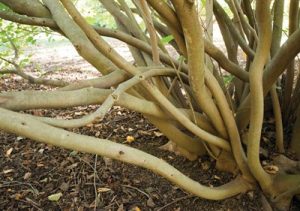
Click image to enlarge.
A specimen of Corylopsis sinensis at Longwood Gardens-more than 50 years old-exhibits a remarkable tangle of light gray branches.
Photo courtesy of Evan Bean
The exposed, full-sun situation unfortunately marred the foliage of Corylopsis sinensis and C. platypetala with burnt edges and leaf spots. The leaves had poor fall color, and old leaves remained on the branches of Corylopsis sinensis along with numerous dark brown fruits, making for an unattractive plant. Plants of this species growing in shadier conditions, however, were not only more upright and graceful, but their leaves turned a beautiful clear yellow in fall and did not have the unfortunate appearance of those growing in full sun.
The average bloom period of Corylopsis sinensis at Longwood typically starts the third week of March and ends by the third week of April. Individual plants usually bloom for two to three weeks in any given year. The floral display of Corylopsis platypetala differed from C. sinensis in presenting longer racemes with flowers opening a few days later.
Corylopsis willmottiae is another species sometimes lumped together under C. sinensis. The specimen growing at Longwood in deep shade is extremely upright and shows how much effect the amount of light received has on the form of plants in the C. sinensis group. The blooms on this plant are borne on 3- to 4-inch racemes, possibly the longest in the genus. Also available is a cultivar of C. sinensis named ‘Spring Purple’, with purple new growth that matures to green.
Overall, Corylopsis sinensis has the potential to be an attractive large shrub or small tree, but due to its size it may be too imposing for most gardens. Plants with the exceptional traits that distinguish Corylopsis platypetala and C. willmottiae as separate species may be difficult to find in the trade, but are worth seeking out for their superior floral displays.
Similarly ranked to Corylopsis sinensis were C. calcicola and C. glandulifera, both grown from seed received from Shanghai Botanical Gardens, and not yet available commercially in the United States.
Corylopsis spicata and its cultivars
Corylopsis spicata was the fourth highest rated winter-hazel in the field trials. It is one of the smaller species in the genus as well as one of the hardier, rated to Zone 5. Smaller-growing, yet mature specimens can still reach 10 to 12 feet tall by 15 feet wide in ideal conditions, though this will take a very long time. Typically they finish off at a more modest size of 6 to 8 feet tall by up to 10 feet wide. The species is quite variable, with some plants exhibiting a more upright and narrow form while others are much more spreading. Generally, this is an arching shrub with distinctly zigzag branches. The effect may be compared to contorted hazelnut, but more subtle, without the fantastic loops and curls that Harry Lauder’s walking stick can achieve, and perhaps easier to fit into a garden because of it.
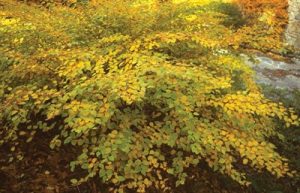
Click image to enlarge.
Mature specimens of Corylopsis pauciflora acquire a flat-topped, vase-like form.
Photo courtesy of Dr. Tomasz Anis_ko.
Corylopsis spicata began flowering in the first week of March, with a slightly darker, truer yellow than the yellow-green of C. sinensis. It had a longer bloom season than most other species, with the first flowers in a raceme opening long before the flowers at the end of the raceme open. This flowering habit gives Corylopsis spicata a long bloom season of three to five weeks. The dark red to purple anthers make a striking contrast upon close observation and a subtle distinction from farther away. Flowers of C. spicata smell slightly but noticeably of primroses, but it is advisable to test them with your own nose prior to purchase if scent is important.
Click image to enlarge.
In the fall, leaves of Corylopsis ‘Winterthur’ grown in sheltered locations turn clear yellow.
Photo courtesy of Evan Bean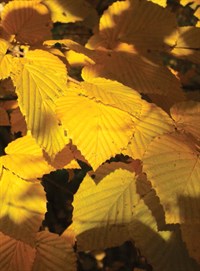
The leaves are relatively large and in some forms possess the loveliest blue-green cast in the genus. Three cultivars with yellow-green foliage are available: ‘Golden Spring’ PP13,821, ‘Aurea’ and ‘Ogon’. ‘Golden Spring’ was discovered as a chance seedling in a controlled sowing in Gifu Prefecture, Japan. A U.S. patent was awarded for it in 2003. The origins of ‘Aurea’ and ‘Ogon’ are unclear. Both names are commonly interchanged with each other and even misapplied to yellow-leaved cultivars of many plants with more creative names, and plants of Corylopsis spicata sold under either name may, in fact, be ‘Golden Spring’. Another cultivar listed is ‘Red Eye’, which likely refers to the red anthers of Corylopsis spicata, though this cultivar seems to be available only in Europe.
The young plants in the shrub trials unfortunately did not have time to develop the grace that comes with age. They were also growing in full sun, hardly ideal for a denizen of the woodland garden. Corylopsis spicata performs best with slightly more shade and more attention to even soil moisture than the other species covered here, likely being more susceptible to drying winds and hot sun in summer due to its large leaves. The flowers are surprisingly heat tolerant, as they survived an April heat wave better than other winter-hazels. C. spicata managed to look decent a week later when the flowers of other species appeared decidedly withered.
The mature specimens at Longwood are growing in significant shade, but can likely tolerate more sun and produce more flowers and better fall color. Gardeners with an evenly moist site protected from strong winds will find this a superb and rewarding plant. Plant enthusiasts who give this unusual shrub a chance will be rewarded with a quirky and bewitching form in maturity, lit in spring by a fairy-like display of glowing yellow blooms.
Corylopsis glabrescens and its cultivars
Corylopsis glabrescens, rated as the third best in the trials, grows as a many-stemmed shrub 8 to 15 feet tall and wide. It may, however, have potential for training as a small tree. It is one of the hardier winter-hazels, surviving down to Zone 5. Mature specimens of this species growing in public areas of Longwood Gardens displayed the best fall foliage color of any winter-hazel, having the cleanest leaves of a good, clear yellow.
Its bloom time ranged from the second week of March until the second week of May, usually two weeks later than other species of Corylopsis. Flowers typically lasted for three to four weeks. Often referred to as the fragrant winter-hazel, C. glabrescens can have a stronger scent than other Corylopsis. A cultivar of C. gotoana named ‘March Jewel’, sometimes treated as C. glabrescens, is a nearly prostrate plant reaching only 18 inches tall by 5 feet wide in 10 years. This is the lowest-growing Corylopsis cultivar available, though it can be difficult to find.
A cultivar of Corylopsis glabrescens was found and named at Longwood Gardens. Receiving the appellation ‘Longwood Chimes’, it was chosen for its strong fragrance and flowers up to 50 percent larger than is typical for the species. As with the species, the later blooming is especially valuable for escaping late frosts that could damage fully open flowers. At Longwood, this selection blooms one to two weeks later than other winter-hazels. As a vegetatively propagated cultivar, it is also more uniform in its features (including fragrance) than other plants of this species offered in the trade.
Young shrubs are spreading to rounded in form and can be trained to fit their garden to an extent. In time ‘Longwood Chimes’ develops a lovely, graceful habit, forming an upright, flat-topped fountain with horizontal branches. For smaller gardens, upright stems can be selected to produce a more tree-like habit, or at least a more upright shrub, to keep valuable garden space available under its branches. The area under this beautiful shrub would be perfect for underplanting with shade perennials. Once the plant is tall enough, a small bench placed under the branches would allow an idyllic vantage from which to enjoy the pendulous, fragrant flowers.
Corylopsis ‘Winterthur’
Smaller than Corylopsis sinensis and C. glabrescens and seemingly with fewer basal stems, Corylopsis ‘Winterthur’ is named after the garden in Delaware where it was discovered. A putative hybrid of C. spicata and C. pauciflora, this winter-hazel can grow to over 12 feet tall and 15 feet wide, with a broad, vase-shaped habit and is hardy to Zone 6a.
Many old specimens of ‘Winterthur’ growing in the public areas of Longwood have been trained to a few stems, giving them an open appearance like a small, spreading tree. The ability to be trained into a tree form may allow ‘Winterthur’ to be more widely used in home landscapes. Rather than completely blocking off a huge chunk of a small garden, the space underneath can be under-planted with lush shade perennials and smaller shrubs.
Young plants of ‘Winterthur’ in the field trials were also noted to be more compact than other Corylopsis, with a pleasing habit and attractive winter form. ‘Winterthur’ received the second highest rating of the Corylopsis grown in the field trials. While they are attractive shrubs, their branch tips tend to flair upward, disturbing the otherwise pleasing horizontal branching pattern. The winter texture was not especially noteworthy. Fall foliage was a good yellow color, but was frequently marred on the more exposed portions with unsightly brown spots and burnt edges, which could potentially be avoided given a slightly more sheltered location. The blooms appeared around the second week of March and lasted until the end of April, smelling very faintly of star fruit. After the flowers faded, purple-flushed new growth provided a subtle secondary display before maturing to a bright green.
Given the high ratings earned in the trials, C. ‘Winterthur’ may be better for growing in more sun than other Corylopsis and could be better than most for gratification at a young age, though the eventual size might exclude it from smaller gardens if not trained to an upright form.
Corylopsis pauciflora
The winter-hazel that received the highest rating in the Longwood Gardens’ shrub trials was Corylopsis pauciflora. It is the shortest species in the genus, growing on average 6 feet tall and wide, with a much finer texture both in and out of leaf than other winter-hazels. Old specimens growing in shade may eventually reach 8 to 10 feet tall. Young plants form symmetrical globes or upright ovals. As they mature, they develop into a flat-topped vase, which may be slightly wider than tall, or upright and narrow depending on the amount of light it receives. In full sun these can be very dense shrubs that may benefit from some selective pruning to thin out crowded stems. In more shaded conditions they become beautiful, narrow vases without developing the stretched-out, straggly appearance of some other shrubs grown in similar light levels.
This small winter-hazel seems more tolerant of sun and heat than other Corylopsis species. It also has the fewest flowers per raceme, only two or three, but makes up for this with copious amounts of buds and individual flowers that are twice as large as other species. Even in dense shade they produce enough flower buds to create a pleasing spring display, while other winter-hazels tend to become too thin to create a large impact. Blooms may begin the second week of March, and the final flowers can last until the first week of May. Typically, individual plants bloom for three to four weeks. This long bloom season and the large numbers of buds help to ensure that a fair amount of flowers will escape late frosts.
After flowering, the small fruits are hardly noticeable. New leaves in spring have a distinctive red-violet edge, giving them extra ornament and a defined look. Fall color develops late and is not as strong in some years as ‘Winterthur’ or ‘Longwood Chimes’, but still can light up a shady understory, complement the red-foliaged fall divas, or make a pleasing combination with purple fall-blooming asters. Corylopsis pauciflora makes an excellent introduction to winter-hazels that will hopefully encourage gardeners to try other members of this beautiful and underused genus.
Other Corylopsis
Some of the winter-hazels included in the trials failed to establish under the conditions of the open nursery field. These included Corylopsis platypetala, C. gotoana and its cultivar ‘March Jewel’, and one group of C. spicata. Interestingly,